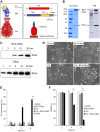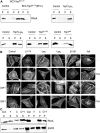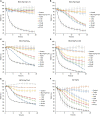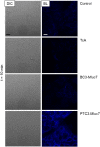Engineering Photorhabdus luminescens toxin complex (PTC) into a recombinant injection nanomachine
- PMID: 31540947
- PMCID: PMC6756610
- DOI: 10.26508/lsa.201900485
Engineering Photorhabdus luminescens toxin complex (PTC) into a recombinant injection nanomachine
Abstract
Engineering delivery systems for proteins and peptides into mammalian cells is an ongoing challenge for cell biological studies as well as for therapeutic approaches. Photorhabdus luminescens toxin complex (PTC) is a heterotrimeric protein complex able to deliver diverse protein toxins into mammalian cells. We engineered the syringe-like nanomachine for delivery of protein toxins from different species. In addition, we loaded the highly active copepod luciferase Metridia longa M-Luc7 for accurate quantification of injected molecules. We suggest that besides the probable size limitation, the charge of the cargo also influences the efficiency of packing and transport into mammalian cells. Our data show that the PTC constitutes a powerful system to inject recombinant proteins, peptides, and potentially, other molecules into mammalian cells. In addition, in contrast to other protein transporters based on pore formation, the closed, compact structure of the PTC may protect cargo from degradation.
© 2019 Ng´ang´a et al.
Conflict of interest statement
The authors declare that they have no conflict of interest.
Figures









Similar articles
-
A syringe-like injection mechanism in Photorhabdus luminescens toxins.Nature. 2013 Mar 28;495(7442):520-3. doi: 10.1038/nature11987. Epub 2013 Mar 20. Nature. 2013. PMID: 23515159
-
XaxAB-like binary toxin from Photorhabdus luminescens exhibits both insecticidal activity and cytotoxicity.FEMS Microbiol Lett. 2014 Jan;350(1):48-56. doi: 10.1111/1574-6968.12321. Epub 2013 Nov 22. FEMS Microbiol Lett. 2014. PMID: 24188660
-
Expression and activity of a probable toxin from Photorhabdus luminescens.Mol Biol Rep. 2009 Apr;36(4):785-90. doi: 10.1007/s11033-008-9246-z. Epub 2008 Apr 13. Mol Biol Rep. 2009. PMID: 18409059
-
The tc genes of Photorhabdus: a growing family.Trends Microbiol. 2001 Apr;9(4):185-91. doi: 10.1016/s0966-842x(01)01978-3. Trends Microbiol. 2001. PMID: 11286884 Review.
-
Toxins and secretion systems of Photorhabdus luminescens.Toxins (Basel). 2010 Jun;2(6):1250-64. doi: 10.3390/toxins2061250. Epub 2010 Jun 1. Toxins (Basel). 2010. PMID: 22069636 Free PMC article. Review.
Cited by
-
Genome-wide dissection reveals diverse pathogenic roles of bacterial Tc toxins.PLoS Pathog. 2021 Feb 4;17(2):e1009102. doi: 10.1371/journal.ppat.1009102. eCollection 2021 Feb. PLoS Pathog. 2021. PMID: 33540421 Free PMC article.
-
Structures of the Insecticidal Toxin Complex Subunit XptA2 Highlight Roles for Flexible Domains.Int J Mol Sci. 2023 Aug 25;24(17):13221. doi: 10.3390/ijms241713221. Int J Mol Sci. 2023. PMID: 37686027 Free PMC article.
-
The Smallest Isoform of Metridia longa Luciferase as a Fusion Partner for Hybrid Proteins.Int J Mol Sci. 2020 Jul 14;21(14):4971. doi: 10.3390/ijms21144971. Int J Mol Sci. 2020. PMID: 32674504 Free PMC article.
-
Some Examples of Bacterial Toxins as Tools.Toxins (Basel). 2024 Apr 23;16(5):202. doi: 10.3390/toxins16050202. Toxins (Basel). 2024. PMID: 38787054 Free PMC article. Review.
-
Host Tropism and Structural Biology of ABC Toxin Complexes.Toxins (Basel). 2024 Sep 19;16(9):406. doi: 10.3390/toxins16090406. Toxins (Basel). 2024. PMID: 39330864 Free PMC article. Review.
References
-
- Aktories K, Koch G (1997) Clostridium botulinum ADP-ribosyltransferase C3. In Bacterial Toxins: Tools in Cell Biology and Pharmacology, Aktories K. (ed), pp 61–69. Weinheim: Chapman & Hall.
Publication types
MeSH terms
Substances
LinkOut - more resources
Full Text Sources
